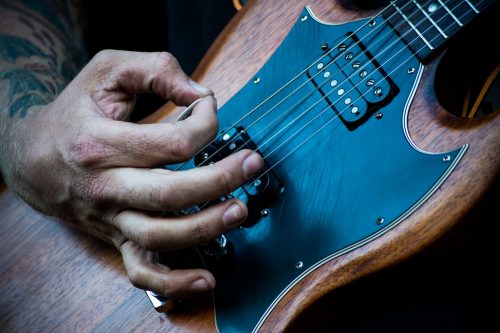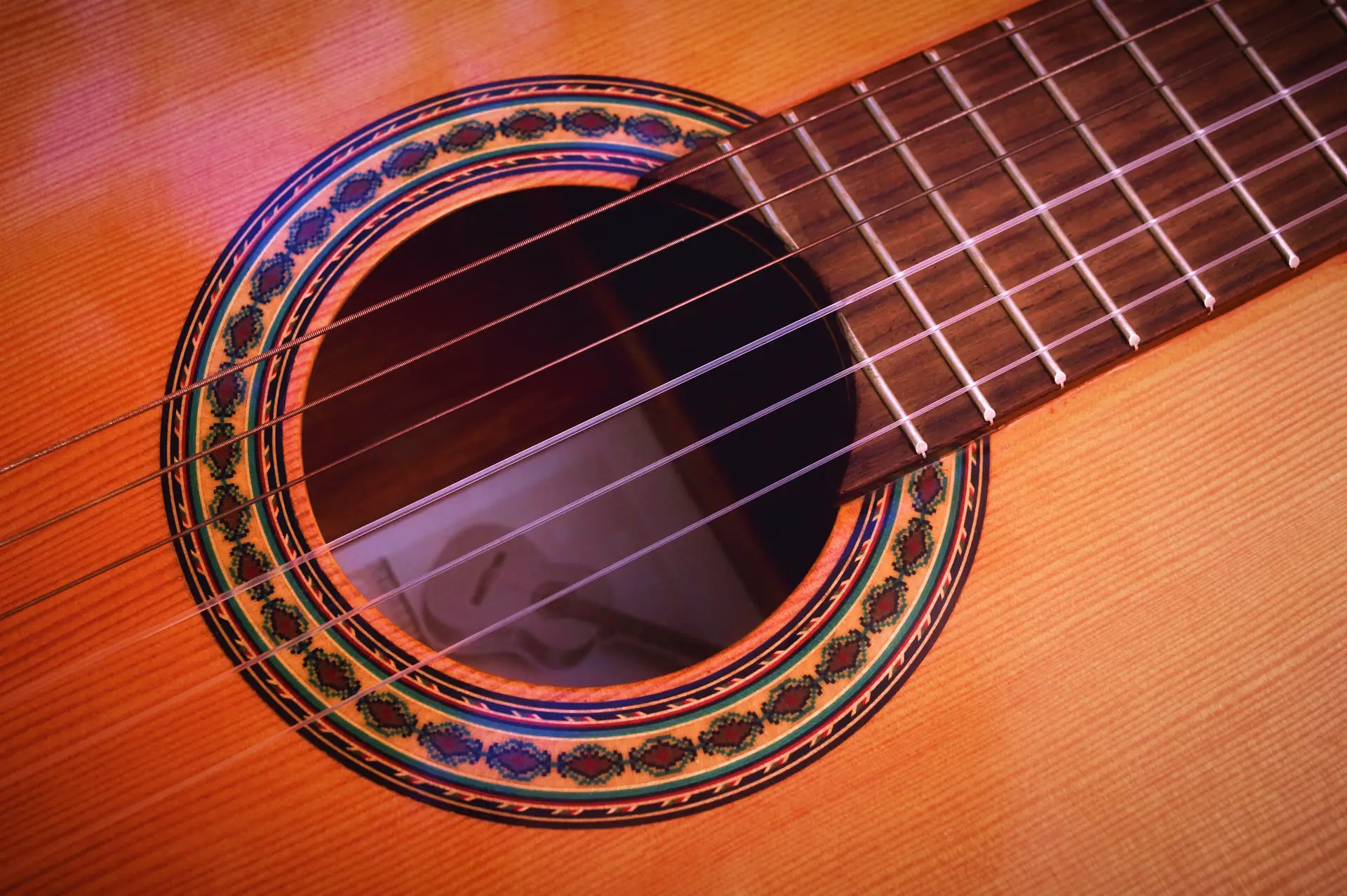The high E string produces a higher frequency sound, whereas the low E string produces lower frequency sound. There are 2 E strings in guitars because a guitar uses four half steps between each open string.
Also, the 2 E string setup (EADGBe) is the most convenient and physically comfortable way of placing the strings.
During the learning course of a guitar, most people often find themselves questioning different aspects of music and musical instruments. I myself was particularly interested in the strings arrangement of a guitar.
In my experience, I’ve found that having intricate knowledge about your instrument greatly benefits you as a musician, and learning more about music theory and how the strings on my guitar are related to it has enhanced my playing ability and musical skill and made me a better guitarist.
In this article, I will try my best to cover all the basic knowledge there is to know about the strings in the following topics:
- Why are there 2 E strings on a guitar?
- What is E tuning
- Why does the guitar start with an E string?
- Does having two E strings produce a better sound?
- Why are there no C or F strings on a guitar?
- Final thoughts
Why Are There 2 E Strings on the Guitar?
There are 2 E strings on guitar because of the standard guitar tuning (EADGBe). With intervals of four half steps between each open string except for the G to B transition, which is a major third, we end up with 2 E strings on a standard guitar.
Strange as it may sound, the thinnest and the thickest string on a guitar are actually the same note, i.e. E note in the musical scale.
You may have noticed that even though the two strings have the same name, they sound completely different from each other when played. This difference is primarily because of the octave difference between them.
I will further elaborate on the octave change ahead but first, let’s have a little overview of the two E strings.
| String name | Position on guitar | Vibration Frequency |
| High E | 1st (bottom most) | 350 Hertz |
| Low E | 6th (top most) | 82 Hertz |
The two strings vary in thickness and also vibrate at different frequencies. This creates a difference in the pitch of the sound produced, hence the octave difference between the two strings.
In simple terms, a change in octave means making the pitch of a note higher or lower, so as the name suggests, the High E or e string will produce a high pitch shrill sound while the Low E or E string will produce a more bass-filled and deep sound.

There are 2 E strings in guitars because a guitar uses four half steps between each open string. And the 2 E string setup (EADGBe) is the most convenient and physically comfortable way of placing the strings.
What Is the E Tuning?
E tuning, more commonly known as standard tuning, is the globally accepted and adopted method of tuning a typical 6-string electric or acoustic guitar. It follows the famous arrangement: EADGBe with intervals of fourths and a single major third between the strings.
The first 4 strings of the guitar ( EADG) are tuned in the same way as an upright bass would be tuned, having intervals of fourths between the open strings. The interval between the G and B strings is a major third, and then again, a fourth interval is followed, giving us EADGBe.
An interval of a fourth means that there is a difference of 4 half steps between two notes or strings. So if you now observe the musical scales, the names of the strings and tuning will make perfect sense.
For E.g. counting 4 intervals after E in the musical scale would mean F.F#, G, G# and then A. Similarly, the tuning of the other strings is also done.
You may wonder why this interval of fourths method is used for the guitar, whereas other stringed instruments like the violin or the mandolin follow the method of the perfect fifth (intervals of fifths) for tuning.
Guitars has a 4 step intervals because of below:
- Reduce tension on hands. 4 Step intervals on guitars makes playing simple chords, scales and notes easy.
- Prevent step gap between E and F. Since the guitar is a large-scale instrument with 6 strings and 20-24 frets on the scale, the tuning in the method of the fifth would create a half step gap between E and F (explained further) which would sound off when played as an open string.
Related article: 7 Simple Ways To Make Guitar Strings Easier To Press
Why Does the Guitar Start With an E String?
The arrangement EADGBe (which starts on E String) has been proven by experts over hundreds of years to be the most musically convenient and physically comfortable way of placing the strings.
This standard guitar tuning makes simple chord transitions and scales playing very easy while also minimizing fret-hand movement.
Guitar playing requires a lot of chord changes, note plucking and strumming patterns. Sometimes the chord transitions are hard to perform with quick successive changes and changes in strumming patterns as well as plucking a few notes.
You may have noticed that unlike other stringed instruments like the violin, which have Four strings only and have a short scale, guitars have larger scales with up to 24 frets and have 6 strings.
The additional 2 strings are added to give more bass and groove to the guitar but may create a challenge for beginner players as the fretting hand has only 4 fingers available while the fretboard has 6 strings, so making chord positions for simple chords even may prove to be a big hurdle.
To ease this tension, early guitar players decided to arrange the guitar strings in such a way that it is easy for the instrumentalist to play the major and minor scales on the frets as well as basic open chords with minimal tension.
After many trials, the E string or the E note was found to be the best possible option to start the guitar with. All the successive strings are tuned with respect to the E string (intervals explained later).
Related article: Heavy Vs Light Guitar Strings: Sound, Playability & Tuning
Does Having Two E Strings Produce a Better Sound?
Two E Strings do not necessarily produce better sound. Sound of an instrument mostly depends on the build quality of the instrument, quality of the strings and on the player. The tuning of a string does not affect the sound quality produced.
If the sound of your guitar is not living up to your expectations, the problem will most likely lie in the quality department and maybe even the skill department, but the tuning of each string and having 2 E strings will most likely not contribute to producing a ‘better’ sound from your guitar.
If you are having trouble with the sound of your guitar, changing the gauge (thickness) of the strings may help in achieving the desired sound. Buzzing etc. can be eradicated by altering the guitar action or getting the frets filed by a professional.
It can be said, though, that because of the two-octave gap between the two strings, when played, the two strings may complement each other, with the low E providing bass and High E taking charge for the treble, which as a whole will sound beautiful if played correctly.
Do the High and Low E Strings Make the Highest and Lowest Sounds?
Being the thinnest and thickest strings on the guitar fretboard, the High and Low E strings can produce the highest and lowest sounds. The high E on the last fret will produce the highest sound, and the Low E will produce the lowest sound if plucked as an open string.
Since the High E is the thinnest string in the guitar, it vibrates with the highest frequency, meaning that it will indeed produce the highest sound possible on a guitar on the highest fret. The same is the case with the Low E string, which, when plucked as an open string, will produce the loudest sound possible.
All the other strings, i.eADGB and the frequencies at which they vibrate on different frets, lie between these two extreme ranges and hence will produce various different sounds in the range according to the guitar player’s requirements.
Related article: Tightened Vs Loose Guitar Strings: Effects To Pitch & Tone
Why Are There No C and F Strings on the Guitar?
There are no C and F Strings on guitar to avoid a half step gap between the first and the last string, which would have an irritating sound.
If the fourth intervals method was followed throughout the 6 strings, the tuning would look something like EADGCF. Now, this seems perfectly fine if we just focus on the immediately previous string.
However, if you look closely, you see both F and E notes in the tuning. Where there is a difference of 4 half steps between every other string, E and F are separated only by a half step, creating a minor second interval between the two which is both inconvenient while playing chords and scales and is also irritating.
To remove this inconvenience, a major third interval was introduced between G and B strings and the fourth pattern was again followed between the B and e string, which gave us the famous and standard EADGBe with no inconveniences and ease of playability.
Final Thoughts
The tuning methods and techniques discussed above have been tested and tried several times by our ancestors and the earliest guitar players. Over hundreds of years later, here we are still using the same methods and appreciate their hard work.
Many expert guitarists in recent times have also used the same methods etc., to show the world their art. So it can be safely concluded that including 2 E strings in a guitar was a good decision and EADGBe is an ideal tuning for learners and experts alike!
Learning to play the guitar is a very interesting journey, and those who develop an interest in it are taken down a very adventurous road. From Jimmy Hendricks to Slash to John Mayer, we all find our favorite artists and bands and learn to play their songs, and eventually move on to either teaching other people what we know or making our own music through the experience we have gained.
Each and every aspect is immensely important in the learning process. All the information provided in this article is either taken from trusted resources or from my own personal experience as a guitarist. I hope that you take away some useful information from here to use in your own music and succeed in your musical ventures.





